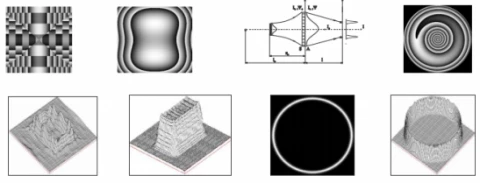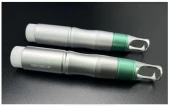Description
In the past 15 years we developed, designed and manufactured a variety of diffractive optical elements that accomplish difficult tasks, conventional optics fails to address effectively.
Dual Wavelength Lens
Laser Components USA, Inc.
Specifications
| Design Wavelength: | Not Specified |
|---|---|
| Effective Focal Length (EFL): | Not Specified |
| Diameter: | Not Specified |
Features
- Uniform Splitting of beams
- Tailored Shaping of spots
- 1D, 2D and 3D spot array generation
- Diffusers and Homogenizers
- Top-Hat Beam Shaping
- Lenslet Arrays, symetric and asymetric
- Beam Sampling
- Chromatic and Spherical Aberration Correction
- Intensity profile management
- Enlongating Depth of Focus
- Frame focusser
- Tailored spot SHAPES and sizes
Applications
- Laser optics
- Imaging
- Spectroscopy
Frequently Asked Questions
What is the Dual Wavelength Lens used for?
The Dual Wavelength Lens is a diffractive optical element that accomplishes difficult tasks that conventional optics fails to address effectively. It features uniform splitting of beams, tailored shaping of spots, 1D, 2D and 3D spot array generation, diffusers and homogenizers, top-hat beam shaping, lenslet arrays, symmetrical and asymmetrical beam sampling, chromatic and spherical aberration correction, intensity profile management, elongating depth of focus, and tailored spot shapes and sizes.
What are the proven solutions developed for high power lasers?
The proven solutions developed for high power lasers include uniform splitting of beams, beam sampling, tailored shaping of spots, chromatic and spherical aberration correction, 1D, 2D and 3D spot array generation, intensity profile management, diffusers and homogenizers, elongating depth of focus, top-hat beam shaping, frame focuser, lenslet arrays, symmetrical and asymmetrical, and tailored spot shapes and sizes.
What is the company's capability in developing and manufacturing diffractive optical elements?
Holo-Or has a full capability of developing and manufacturing diffractive optical elements in clean room facilities. The company employs highly skilled technical personnel and occupies a production facility at the Kiryat Weizmann High-Tech Industrial Park, Rehovot, Israel. The company holds the key patents on its method of manufacturing multi-level elements.
What services and capabilities does Holo-Or offer?
Holo-Or offers diffractive optical elements, custom and stock, diffractive design and performance analyses, optical design incorporating diffractive optics, reactive ion and wet etching and photolithography for visible and IR materials, and mask fabrication. The company also has an in-house elaborated software DOECAD software for design, mask files generation, and computer simulation of diffractive optical elements.
What is the Diffractive-Corrected Focusing Lens?
The Diffractive-Corrected Focusing Lens is a single diffractive-corrected focusing lens that demonstrates sharp focusing with diffraction-limited spot-size. The lens is fabricated by etching an aberrations-correction diffractive microrelief pattern on the plane side of a bulky spherical plano-convex lens. It comes in different part numbers, wavelengths, effective focal lengths, and diameters.
Similar Products
Thank You!
Your inquiry has been received.
Create an account by adding a password
Why create an account?
- Auto-complete inquiry forms
- View and manage all your past messages
- Save products to your favorites
- Close your account anytime — no hassle

